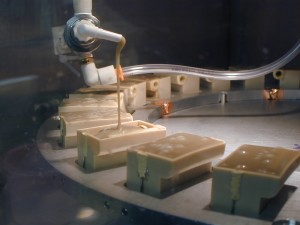The Importance of Vacuum Degas in
Adhesive Dispensing Equipment
Ashby Cross often incorporates a vacuum degas system in their meter, mix equipment. Vacuum degas can include each side of the adhesive or just a single side.
There are several reasons degas is incorporated into the design. They include material sensitivity to moisture or air, wide ratios such as 100:7, viscosity, and application.
Many urethane’s are moisture sensitive and should be vacuum degassed in the tanks to eliminate the chance of crystal formation. Typically when the equipment is off-line a vacuum is applied to the tank to remove air then the tank is locked up under vacuum.
In applications with wide mix ratios it is always important to degas the resin (usually filled and high in viscosity). The catalyst is generally unfilled and thin which usually does not require vacuum degas. High viscosity, filled resins will compress during processing. This always leads to phasing; a term used to describe how the two materials exit the mix valve, and enter the static mixer, at different times. Each time the valve opens the resin could flow before the catalyst or the opposite. At this point the mix is off ratio. As static mixing is generally plug flow, the off-ratio adhesive makes its way down the static mixer and into the part. When soft spots occur in the finished product it is likely due to phasing from the machine.
All vacuum degas systems include an agitator that slowly rotates within the tank exposing all the material to the surface vacuum. In addition, high viscosity adhesives usually require heating to reduce viscosity which enhances vacuum degas.
Certain applications such as clear-coating, high voltage potting, casting, and vacuum chamber potting require air-free dispensing to prevent failure or cosmetic blemishes in the product.
In these cases both sides of the adhesive are vacuum degassed.
In applications where adhesive is dispensed within a vacuum chamber vacuum degassing of the adhesive to a level lower vacuum level than the vacuum chamber will eliminate splattering of the adhesive during dispensing.



